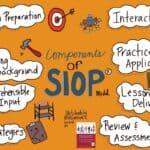Stage 1 The first stage is the silent/receptive stage. During this stage, the individual understands little or no spoken English, but can understand pictures, gestures, dramatizations, and translations of directions into the native language. In this stage, background knowledge in the native language is very important and may influence whether this stage lasts several hours or several months. It’s called the silent/receptive stage but different individual may behave differently based on their personality.
Stage 2 The second stage is the early production stage. The individual understands simple directions with continued support of pictures, gestures, and dramatizations. Understanding is best when sentence structures and words used are simple, and repetition and paraphrasing are used frequently. This stage may last about six months. During this period, language learners typically acquire an understanding of up to 1,000 words. They may also learn to speak some words and begin forming short phrases.
Stage 3 During the third stage, speech emergence, the individual understands complex directions broken down into simple steps; understands best when given time between each step to check for understanding and to clarify any confusion. By this stage, learners typically acquire a vocabulary of up to 3,000 words. Communication occurs by putting the words in short phrases, sentences, and questions. They may not be grammatically correct. Reading comprehension and writing in the second language may be seen here.
Stage 4 This stage is called intermediate fluency. During this stage, which may last for a year or more after speech emergence, learners typically have a vocabulary of as many as 6,000 words. They usually acquire the ability to communicate in writing and speech using more complex sentences. It is during this stage that learners begin actually thinking in their second language and this helps them gain more proficiency in speaking it.
10 Practices that Every Teacher Should Include in a Lesson
Stage 5 The final stage is continued language development/advanced fluency. This is the stage when the individual understands complex directions with little or no support. It takes most learners at least two years to reach this stage, and then up to 10 years to achieve full mastery of the second language in all its complexities and nuances.
Check out the following link to access frequently asked questions on ESL and Bilingual Law in New Jersey.
https://hctutorial.com/esl-and-bilingual-frequently-asked-questions/
Free Sheltered Instruction Online Course
https://www.youtube.com/channel/UCL_e48z694tw9bqI1mUbHjg
Math and Language Arts Videos in Haitian Creole



